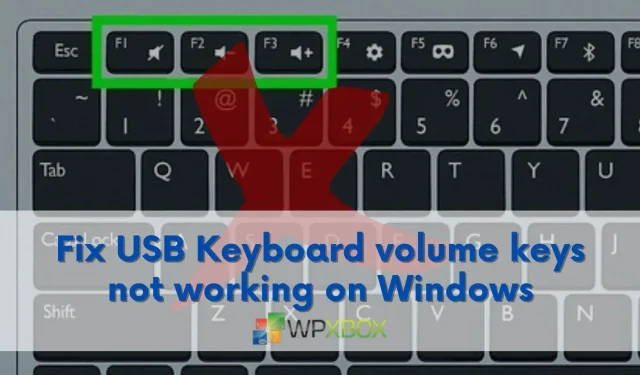Repair Windows 11/10 USB Keyboard Volume Keys Not Functioning

A broken USB keyboard can be very annoying, especially if the volume keys aren’t functional. It impacts desktop and laptop peripherals alike, especially so in the Windows 11 and 10 era. Customizing sound levels at an event or presentation requires volume control; if this crucial feature isn’t functioning properly, establishing the ideal ambience you desired becomes quite challenging. This article will examine solutions for Windows 11/2010 keyboard volume key issues.
How to Repair Windows 11/10’s Non-Working USB Keyboard Volume Keys
There are various potential reasons why the volume keys on your keyboard won’t function, and each one may have a unique solution. Make sure to look at each one to determine which is best for your problem. All of the following is covered:
- Install the keyboard drivers again
- Launch HIDserv
- Alternate USB Ports
- Run the Windows Keyboard Troubleshooter to see if other keys are working properly.
Now let’s take a closer look at each of these approaches.
1] Install the keyboard drivers again
Keyboard drivers frequently become corrupted as a result of a program conflict or the removal of crucial files. Reinstalling the keyboard drivers is advised to resolve this problem. This is how you do it:
- By simultaneously pressing the Windows key and X, you may open the Device Manager. From the menu that displays, choose Device Management.
- Find and expand the Keyboard category in Device Manager, then right-click on the particular keyboard driver you want to remove.
- When prompted, click Uninstall twice to confirm your choice to remove the keyboard driver. The device and its drivers will be removed.
- Restart your computer next to make the keyboard visible. After that, download and install the driver from the OEM website.
2] Launch HIDserv
The Windows service HIDserv is in charge of designating and enabling hotkeys on the keyboard, including the volume keys, play and pause buttons, and others. This is how to launch HIDserv:
- Ctrl+Shift+Esc is a keyboard shortcut that you can use to quickly access the Windows Task Manager.
- Navigate to the Services tab in the Task Manager window to continue.
- Check for the HIDserv service and note its current status.
- If it is stopped, perform a right-click on HIDserv and select Start from the pop-up context menu.
- Test your volume keys to check if they work after following these procedures.
3] Alternate USB Ports
Sometimes, the issue may be with the software rather than the hardware parts of your system. If your computer has another USB port that is functional and compatible in such circumstances, try attaching the keyboard to that port and see if it behaves as you would expect. If the problem still exists even after attempting a new port, this can be a sign that the USB interface is broken.
A different computer can be used to test the keyboard’s operation. Assume that the keyboard functions flawlessly when it is linked to another device. The likelihood that your original computer’s USB port is having problems or failing increases in that situation.
4] Verify if other keys are operating properly.
You can occasionally find that only a few keys on your keyboard stop working properly. Membrane keyboards, which are more prone to such issues, are particularly affected by this problem. You may discover that some keys are inoperative. Carefully removing them from the keyboard and properly cleaning any dust or debris that has accumulated beneath those keys may be useful. You can get their functionality back by doing this.
5] Activate the Windows Keyboard Troubleshooter
The useful tool known as Windows troubleshooter has been part of the operating system for a very long time. On your Windows computer, troubleshooters can be used to identify the main source of hardware and software faults and how to fix them. To use Windows Troubleshooter to resolve keyboard issues, follow these steps:
- Open Windows settings by pressing the Windows+I key.
- Now, open the system section from the left pane.
- In the system settings, look for the Troubleshooters option and open it.
- In Troubleshooters, click on the Other troubleshooters option.
- Now, scroll down to find the keyboards option. Click on the Run button next to it.
Now, this will reveal the root causes of your keyboard’s problems and make suggestions for potential solutions.
Conclusion:
This article discusses potential solutions for the keyboard’s non-functioning volume keys on Windows 11/Windows 10 computers. One of the most crucial computer peripherals is the keyboard, therefore having a broken one might make your work difficult. To prevent any problems, keep the auxiliary equipment operational. We hope the article was helpful to you. Make sure to spread the word to everyone, if possible.
How Can I Turn on the Volume Button on My Windows Keyboard?
If your keyboard has dedicated volume buttons and they aren’t functioning, there are only a few possibilities. If the keyboard only functions with Fn keys or you haven’t loaded the keyboard driver, there can be a minor bug that can be fixed with a PC restart. Installing the driver from the Manufacturer website or unlocking the FN key on your laptop are quick fixes for this issue.
Is a Keyboard Lock Button Available?
For some of its models, several OEMs provide special keyboard lock buttons. It is accessible for both laptops and external keyboards. They frequently have indicators, like lights, so you can immediately determine what they are. If you can’t, look in the user handbook. If there is a glitch, turning it on or off should assist you resolve the issue.
Leave a Reply